Professor Ashok Goel of Georgia Tech developed an artificially intelligent teaching assistant to help handle the enormous number of student questions in the online class, Knowledge-Based Artificial Intelligence. This online course is a core requirement of Georgia Tech's online Master of Science in Computer Science program. Professor Goel already had eight teaching assistants, but that wasn't enough to deal with the overwhelming number of daily questions from students.
Many students drop out of online courses because of the lack of teaching support. When students feel isolated or confused and reach out with questions that go unanswered, their motivation to continue begins to fade. Professor Goel decided to do something to remedy this situation and his solution was to create a virtual assistant named Jill Watson, which is based on the IBM Watson platform.
Goel and his team developed several versions of Jill Watson before releasing her to the online forums. At first, the virtual assistant wasn't too great. But Goel and his team sourced the online discussion forum to find all the 40,000 questions that had ever been asked since the class was launched. Then they began to feed Jill with the questions and answers. After some adjustments and sufficient time, Jill was able to answer the students' questions correctly 97% of the time. The virtual assistant became so advanced and realistic that the students didn't know she was a computer. The students, who were studying artificial intelligence, were interacting with the virtual assistant and couldn't tell it apart from a real human being. Goel didn't inform them about Jill's true identity until April 26. The students were actually very positive about the experience.
The goal of Professor Goel's virtual assistant next year is to take over answering 40% of all the questions posed by students on the online forum. The name Jill Watson will, of course, change to something else next semester. Professor Goel has a much rosier outlook on the future of artificial intelligence than, say, Elon Musk, Stephen Hawking, Bill Gates or Steve Wozniak.
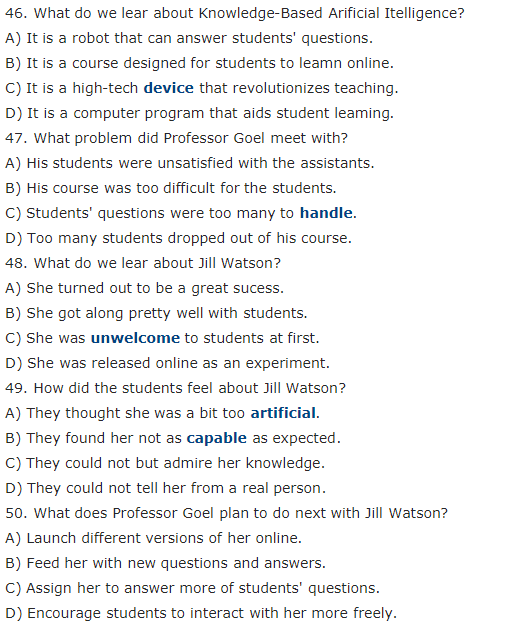
BCADC
佐治亚理工学院的 Ashok Goel 教授开发了一种人工智能助教,以帮助处理在线课程“基于知识的人工智能”中的大量学生问题。该在线课程是佐治亚理工学院计算机科学在线硕士课程的核心要求。Goel 教授已经有八名助教,但这还不足以应付学生每天提出的海量问题。
许多学生因为缺乏教学支持而退出在线课程。当学生感到孤立或困惑并提出未得到解答的问题时,他们继续学习的动力开始减弱。Goel 教授决定采取一些措施来补救这种情况,他的解决方案是创建一个名为 Jill Watson 的虚拟助手,它基于 IBM Watson 平台。
Goel 和他的团队在将 Jill Watson 发布到在线论坛之前开发了多个版本。起初,虚拟助手并不太好。但是 Goel 和他的团队找到了在线讨论论坛,以查找自课程推出以来所提出的所有 40,000 个问题。然后他们开始用问题和答案喂吉尔。经过一些调整和充足的时间,吉尔能够正确回答学生问题的概率为 97%。虚拟助手变得如此先进和现实,以至于学生们都不知道她是一台电脑。正在学习人工智能的学生正在与虚拟助手互动,无法将其与真人区分开来。Goel 直到 4 月 26 日才告诉他们吉尔的真实身份。学生们实际上对这次经历非常积极。
Goel 教授的虚拟助理明年的目标是接管回答学生在在线论坛上提出的所有问题的 40%。吉尔沃森这个名字当然会在下学期改成别的名字。Goel 教授对人工智能的未来前景比埃隆·马斯克、斯蒂芬·霍金、比尔·盖茨或史蒂夫·沃兹尼亚克要乐观得多。
Textbooks represent an 11 billion dollar industry, up from $8 billion in 2014. Textbook publisher Pearson is the largest publisher -- of any kind -- in the world.
It costs about $1 million to create a new textbook. A freshman textbook will have dozens of contributors, from subject-matter experts through graphic and layout artists to expert reviewers and classroom testers. Textbook publishers connect professors, instructors and students in ways that alternatives, such as open e-textbooks and open educational resources, simply do not. This connection happens not only by means of collaborative development, review and testing, but also at conferences where faculty regularly decide on their textbooks and curricula for the coming year.
It is true that textbook publishers have recently reported losses, largely due to students renting or buying used print textbooks. But this can be chalked up to the excessively high cost of their books -- which has increased over 1,000 percent since 1977. A restructuring of the textbook industry may well be in order. But this does not mean the end of the textbook itself.
While they may not be as dynamic as an iPad, textbooks are not passive or lifeless. For example, over the centuries, they have simulated (模拟) dialogues in a number of ways. From 1800 to the present day, textbooks have done this by posing questions for students to answer inductively (归纳性地). That means students are asked to use their individual experience to come up with answers to general questions. Today's psychology texts, for example, ask: "How much of your personality do you think you inherited?" while ones in physics say: "How can you predict where the ball you tossed will land?"
Experts observe that "textbooks come in layers, something like an onion." For an active learner, engaging with a textbook can be an interactive experience. Readers proceed at their own pace. They "customize" their books by engaging with different layers and linkages. Highlighting, Post-It notes, dog-ears and other techniques allow for further customization that students value in print books over digital forms of books.
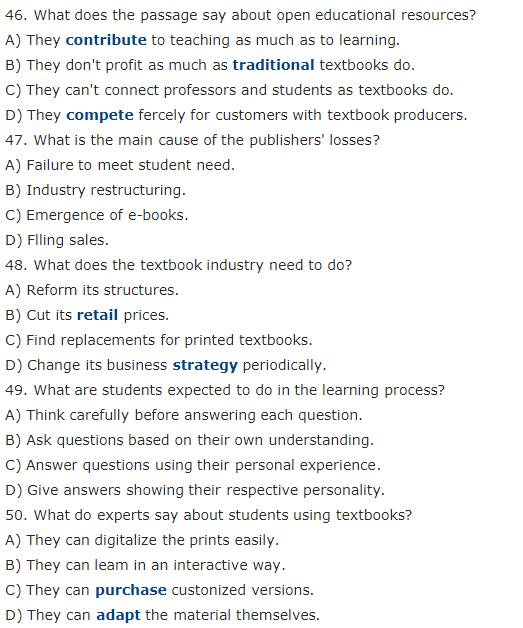
When we think of animals and plants, we have a pretty good way of dividing them into two distinct groups: one converts sunlight into energy and the other has to eat food to make its energy. Well, those dividing lines come crashing down with the discovery of a sea slug (海蛞蝓) that's truly half animal and half plant. It's pretty incredible how it has managed to hijack the genes of the algae (藻类) on which it feeds.
The slugs can manufacture chlorophyll, the green pigment (色素) in plants that captures energy from sunlight, and hold these genes within their body. The term kleptoplasty is used to describe the practice of using hijacked genes to create nutrients from sunlight. And so far, this green sea slug is the only known animal that can be truly considered solar-powered, although some animals do exhibit some plant-like behaviors. Many scientists have studied the green sea slugs to confirm that they are actually able to create energy from sunlight.
In fact, the slugs use the genetic material so well that they pass it on to their future generations. Their babies retain the ability to produce their own chlorophyll, though they can't generate energy from sunlight until they've eaten enough algae to steal the necessary genes, which they can't yet produce on their own.
"There's no way on earth that genes from an alga should work inside an animal cell," says Sidney Pierce from the University of South Florida. "And yet here, they do. They allow the animal to rely on sunshine for its nutrition. So if something happens to their food source, they have a way of not starving to death until they find more algae to eat."
The sea slugs are so good at gathering energy from the sun that they can live up to nine months without having to eat any food. They get all their nutritional needs met by the genes that they've hijacked from the algae.
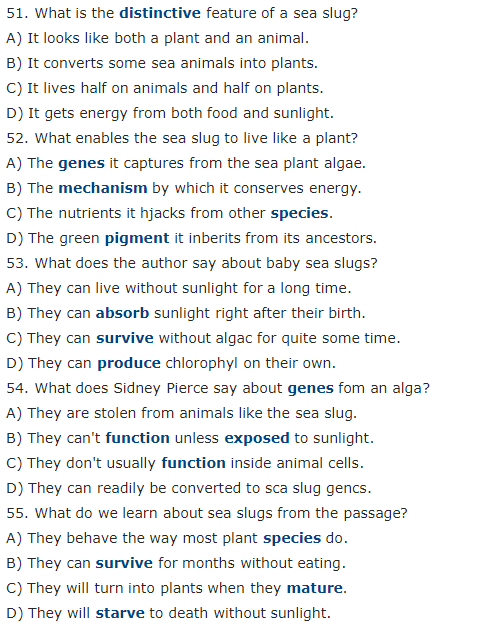
For this part, you are allowed 30 minutes to write a letter to a foreign friend who wants to teach English in China. Please recommend a city to him. You should write at least 120 words but no more than 180 words.
A) We've always been a hands-on, do it-yourself kind of nation. Ben Franklin, one of America's founding fathers, didn't just invent the lightning rod. His creations include glasses, innovative stoves and more.
B) Franklin, who was largely self-taught, may have been a genius, but he wasn't really an exception when it comes to American making and creativity.
C) The personal computing revolution and philosophy of disruptive innovation of Silicon Valley grew, in part, out of the creations of the Homebrew Computer Club, which was founded in a garage in Menlo Park, California, in the mid-1970s. Members-including guys named Jobs and Wozniak-started making and inventing things they couldn't buy.
D) So it's no surprise that the Maker Movement today is thriving in communities and some schools across America. Making is available to ordinary people who aren't tied to big companies, big defense labs or research universities. The maker philosophy echoes old ideas advocated by John Dewey, Montessori, and even ancient Greek philosophers, as we pointed out recently.
E) These maker spaces are often outside of classrooms, and are serving an important educational function. The Maker Movement is rediscovering learning by doing, which is Dewey's phrase from 100 years ago. We are rediscovering Dewey and Montessori and a lot of the practices that they pioneered that have been forgotten or at least put aside. A maker space is a place which can be in a school, but it doesn't look like a classroom. It can be in a library. It can be out in the community. It has tools and materials. It's a place where you get to make things based on your interest and on what you, re learning to do.
F) Ideas about learning by doing have struggled to become mainstream educationally, despite being old concepts from Dewey and Montessori, Plato and Aristotle, and in the American context, Ralph Emerson, on the value of experience and self-reliance. It's not necessarily an efficient way to learn. We learn, in a sense, by trial and error. Learning from experience is something that takes time and patience. It's very individualized. If your goal is to have standardized approaches to learning, where everybody learns the same thing at the same time in the same way, then learning by doing doesn't really fit that mold anymore. It's not the world of textbooks. It's not the world of testing.
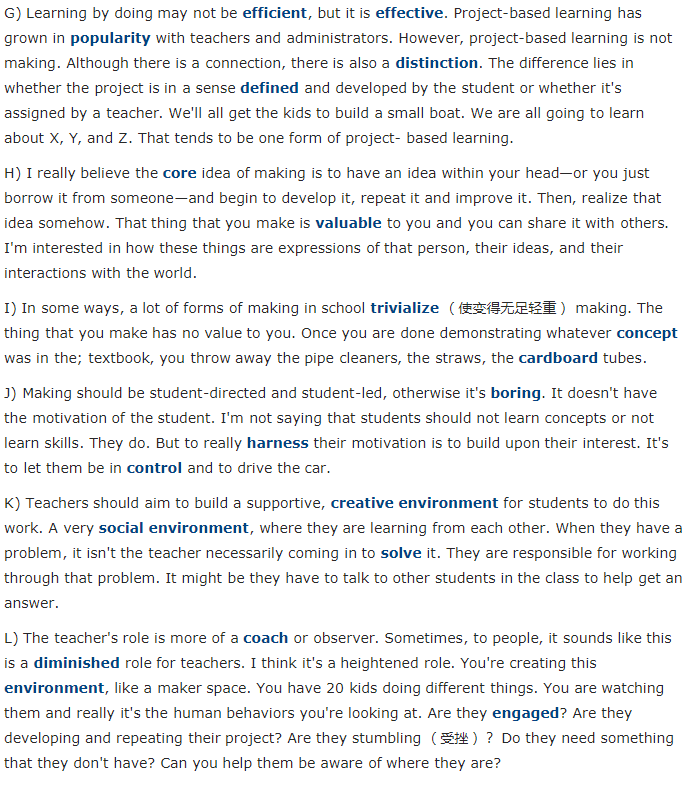
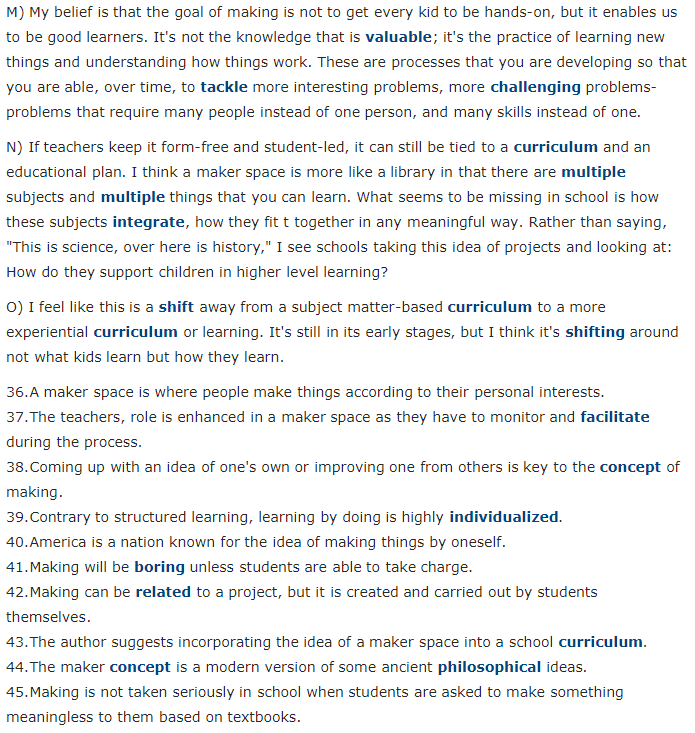
Directions: For this part, you are allowed 30 minutes to write a letter to a foreign friend who wants to study in China. Please recommend a university to him. You should write at least 120 words but no more than 180 words.
Directions: For this part, you are allowed 30 minutes to write a letter to a foreign friend who wants to teach English. Please recommend a city to him. You should write at least 120 words but no more than 180 words.
中国,地球上最吸引人的国家之一,有5000多年的历史,是目前全球第二大经济体(the second largest economy)。随着广泛的经济改革,中国正经历着显著、快速的变化。1949年以前的中国极端贫困、收入不平衡(incomeinequalities)、国家不安全。由于经济改革,从1980年开始,人民的生活水平开始提升至基本水平之上。全国人口有了足够的食物、衣服和住房,普通家庭可以吃得起各种各样的食物,穿得上时尚的衣服。
The fifth largest city in US passed a significant soda tax proposal that will levy (征税)1.5 cents per liquid ounce on distributors.
Philadelphil's new measure was approved by a 13 to 4 city council vote. It sets a new bar for similar initiatives across the country. It is proof that taxes on sugary drinks can win substantial support outside super-liberal areas. Until now, the only city to successfully pass and implement a soda tax was Berkeley, California, in 2014.
The tax will apply to regular and diet sodas, as well as other drinks with adder sugar, such as Gatorade and iced teas. It's expected to raise $410 million over the next five years, most of which will go toward funding a universal pre-kindergarten program for the city.
While the city council vote was met with applause inside the council room, opponents to the measure, including soda lobbyists, made sharp criticisms and a promise to challenge the tax in court.
"The tax passed today unfairly singles out beverages — including low —and no-calorie choices," said Lauren Kane, spokeswoman for the American Beverage Association. "But most importantly, it is against the law. So we will side with the majority of the people of Philadelphia who oppose this tax and take legal action to stop it."
An industry-backed anti-tax campaign has spent at least $4 million on advertisements. The ads criticized the measure, characterizing it as a "grocery tax".
Public health groups applauded the approved tax as step toward fixing certain lasting health issues that plague Americans. "The move to recapture a small part of the profits from an industry that pushed a product that contributes to diabetes, obesity and heart disease in poorer communities in order to reinvest in those communities will sure be inspirational to many other places," said Jim Krieger, executive director of Healthy Food America. "indeed, we are already hearing from some of them. It's not 'just Berkeley' anymore."
Similar measures in California's Albany, Oakland, San Francisco and Colorado's Boulder are becoming hot-button issues. Health advocacy groups have hinted that even more might be coming.
46. What does the passage say about the newly-approved soda tax in Philadelphia?
A) It will change the lifestyle of many consumers.
B) It may encourage other US cities to fllow suit.
C) It will cut soda consumption among low-income communities.
D) It may influence the marketing strategies of the soda business.
47. What will the opponents probably do to respond to the soda tax proposal?
A) Bargain with the city council.
B) Refuse to pay additional tax.
C) Take legal action against it.
D) Try to win public support.
48. What did the industry-backed anti-tax campaign do about the soda tax proposal?
A) It tried to arouse hostile felings among consumers.
B) It tried to win grocers' support against the measure.
C) It kept sending ltters of protest to the media.
D) It criticized the measure through advertising.
49. What did public health groups think the soda tax would do?
A) Alert people to the risk of sugar-induced diseases.
B) Help people to fix certain long-time health issues.
C) Add to the fund for their rescarch on discases.
D) Benefit low-income people across the country.
50. What do we lear about similar measures concening the soda tax in some other citics?
A) They are becoming rather sensitive issues.
B) They are spreading panic in the soda industry.
C) They are reducing the incidence of sugar-induced diseases.
D) They are taking away a lot of proft from the soda industry.
鱼是春节前夕餐桌上不可或缺的一道菜,因为汉语中“鱼”字的发音与“余”字的发音相同。正由于这个象征性的意义,春节期间鱼也作为礼物送给亲戚朋友。鱼的象征意义据说源于中国传统文化。中国人有节省的传统,他们认为节省得愈多,就感到愈为安全。今天,尽管人们愈来愈富裕了,但他们仍然认为节省是一种值得弘扬的美德。
生活在中国不同地区的人们饮食多种多样。北方人主要吃面食,南方人大多吃米饭。在沿海地区,海鲜和淡水水产品在人们饮食中占有相当大的比例,而在其他地区人们的饮食中,肉类和奶制品更为常见。四川、湖南等省份的居民普遍爱吃辛辣食物,而江苏和浙江人更喜欢甜食。然而,因为烹饪方式各异,同类食物的味道可能会有所不同。